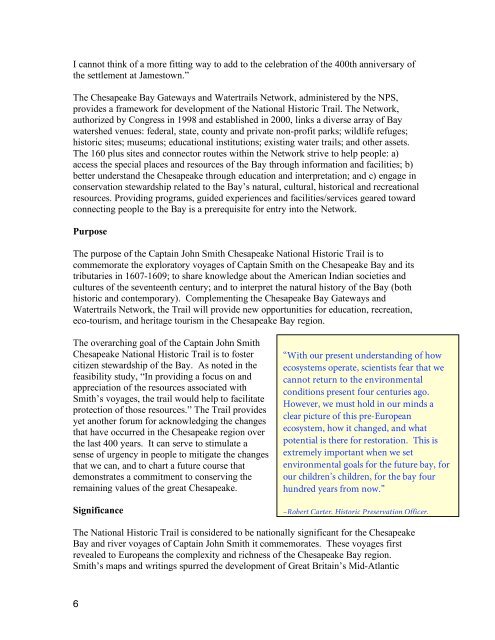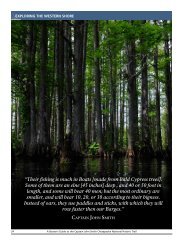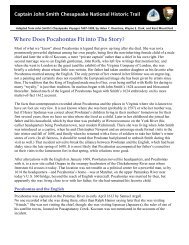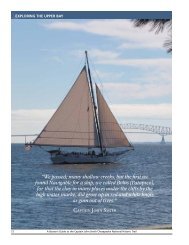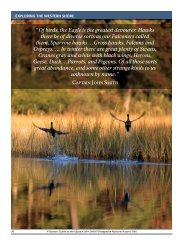Draft Interpretive Plan Join the adventure! - Captain John Smith ...
Draft Interpretive Plan Join the adventure! - Captain John Smith ...
Draft Interpretive Plan Join the adventure! - Captain John Smith ...
Create successful ePaper yourself
Turn your PDF publications into a flip-book with our unique Google optimized e-Paper software.
I cannot think of a more fitting way to add to <strong>the</strong> celebration of <strong>the</strong> 400th anniversary of<br />
<strong>the</strong> settlement at Jamestown.”<br />
The Chesapeake Bay Gateways and Watertrails Network, administered by <strong>the</strong> NPS,<br />
provides a framework for development of <strong>the</strong> National Historic Trail. The Network,<br />
authorized by Congress in 1998 and established in 2000, links a diverse array of Bay<br />
watershed venues: federal, state, county and private non-profit parks; wildlife refuges;<br />
historic sites; museums; educational institutions; existing water trails; and o<strong>the</strong>r assets.<br />
The 160 plus sites and connector routes within <strong>the</strong> Network strive to help people: a)<br />
access <strong>the</strong> special places and resources of <strong>the</strong> Bay through information and facilities; b)<br />
better understand <strong>the</strong> Chesapeake through education and interpretation; and c) engage in<br />
conservation stewardship related to <strong>the</strong> Bay’s natural, cultural, historical and recreational<br />
resources. Providing programs, guided experiences and facilities/services geared toward<br />
connecting people to <strong>the</strong> Bay is a prerequisite for entry into <strong>the</strong> Network.<br />
Purpose<br />
The purpose of <strong>the</strong> <strong>Captain</strong> <strong>John</strong> <strong>Smith</strong> Chesapeake National Historic Trail is to<br />
commemorate <strong>the</strong> exploratory voyages of <strong>Captain</strong> <strong>Smith</strong> on <strong>the</strong> Chesapeake Bay and its<br />
tributaries in 1607-1609; to share knowledge about <strong>the</strong> American Indian societies and<br />
cultures of <strong>the</strong> seventeenth century; and to interpret <strong>the</strong> natural history of <strong>the</strong> Bay (both<br />
historic and contemporary). Complementing <strong>the</strong> Chesapeake Bay Gateways and<br />
Watertrails Network, <strong>the</strong> Trail will provide new opportunities for education, recreation,<br />
eco-tourism, and heritage tourism in <strong>the</strong> Chesapeake Bay region.<br />
The overarching goal of <strong>the</strong> <strong>Captain</strong> <strong>John</strong> <strong>Smith</strong><br />
Chesapeake National Historic Trail is to foster<br />
citizen stewardship of <strong>the</strong> Bay. As noted in <strong>the</strong><br />
feasibility study, “In providing a focus on and<br />
appreciation of <strong>the</strong> resources associated with<br />
<strong>Smith</strong>’s voyages, <strong>the</strong> trail would help to facilitate<br />
protection of those resources.” The Trail provides<br />
yet ano<strong>the</strong>r forum for acknowledging <strong>the</strong> changes<br />
that have occurred in <strong>the</strong> Chesapeake region over<br />
<strong>the</strong> last 400 years. It can serve to stimulate a<br />
sense of urgency in people to mitigate <strong>the</strong> changes<br />
that we can, and to chart a future course that<br />
demonstrates a commitment to conserving <strong>the</strong><br />
remaining values of <strong>the</strong> great Chesapeake.<br />
“With our present understanding of how<br />
ecosystems operate, scientists fear that we<br />
cannot return to <strong>the</strong> environmental<br />
conditions present four centuries ago.<br />
However, we must hold in our minds a<br />
clear picture of this pre-European<br />
ecosystem, how it changed, and what<br />
potential is <strong>the</strong>re for restoration. This is<br />
extremely important when we set<br />
environmental goals for <strong>the</strong> future bay, for<br />
our children’s children, for <strong>the</strong> bay four<br />
hundred years from now.”<br />
Significance<br />
–Robert Carter, Historic Preservation Officer,<br />
Virginia Department of Historic Resources<br />
The National Historic Trail is considered to be nationally significant for <strong>the</strong> Chesapeake<br />
Bay and river voyages of <strong>Captain</strong> <strong>John</strong> <strong>Smith</strong> it commemorates. These voyages first<br />
revealed to Europeans <strong>the</strong> complexity and richness of <strong>the</strong> Chesapeake Bay region.<br />
<strong>Smith</strong>’s maps and writings spurred <strong>the</strong> development of Great Britain’s Mid-Atlantic<br />
6


